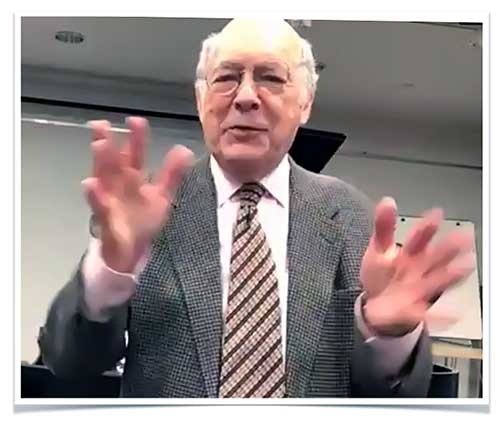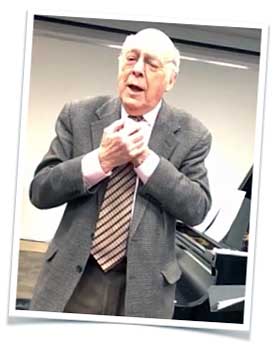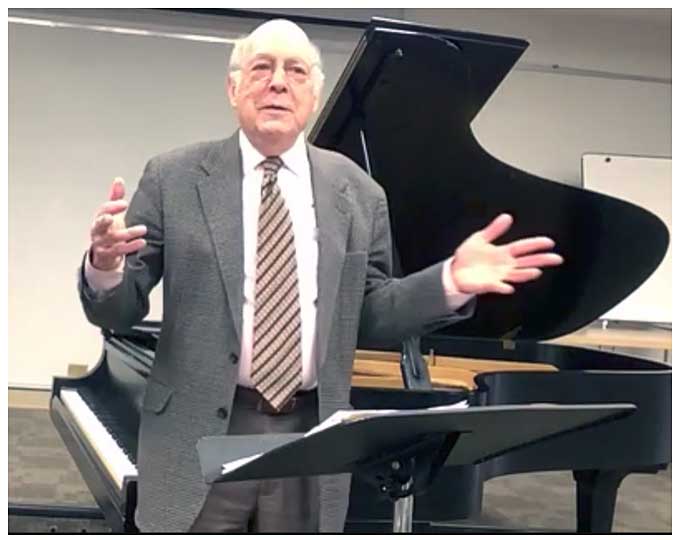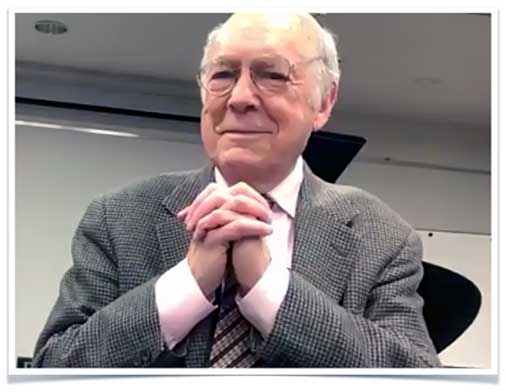Music Educators Association of New Jersey
Serving teachers and students since 1927


 Victor Rosenbaum – What It Takes to Make Music and the Role of Inspiration
Victor Rosenbaum – What It Takes to Make Music and the Role of InspirationVictor Rosenbaum included commentary and performance of many excerpts of musical masterpieces in his fascinating presentation. Hostess Beverly Shea read an abridged list of his nationwide and international appearances as soloist, lecturer, master teacher and professor in her introduction to MEA library and Zoom audiences. A former student of Rosina Lhévinne and Leonard Shure, he has held positions in prestigious schools worldwide. For more information, see necmusic.edu/faculty/victor-rosenbaum
Victor Rosenbaum opened with comments about the power of music made by such luminaries as Confucius, Victor Hugo, Albert Einstein, Nietzsche, and Ludwig van Beethoven. Music goes back to prehistoric times. The essence of music is found in singing. Following voice, the oldest instrument, were sticks and stone (percussion) and reeds (flutes).
 Most music is not written: modern scores are a relatively recent development. While adherence to a score is fundamental among classical musicians, that is just the beginning of playing music. Interpretation of a score involves more than a formulaic, simplistic approach. To access the power inherent in music, we must explore basic musical elements.
Most music is not written: modern scores are a relatively recent development. While adherence to a score is fundamental among classical musicians, that is just the beginning of playing music. Interpretation of a score involves more than a formulaic, simplistic approach. To access the power inherent in music, we must explore basic musical elements.
Mr. Rosenbaum stated that our role as teachers is to instill the love of music in our students. The MEA title reflects that mission: to teach music appreciation at the highest level. That love begins with singing, that is, actually singing. Ask students to sing. Another activity would be composing. Just as students love to create, to draw, to write stories, they can learn to love to compose. Encourage them. “Pianists are re-creative artists,” he said. “The pianist and author Charles Rosen said the study of composition should be at the core of music education so that students might experience the working out of ideas. That will lead to great appreciation of music.” Students will then understand that just as composing involves labor, so does practicing. Along with singing and composing, musical analysis is essential to fully understand and appreciate their pieces. Mr. Rosenbaum enthusiastically cited a motif from a Beethoven symphony that, when altered beyond a literal sequence, became a beautiful melody. “Ask your students to analyze their music,” he advised. “Kids like to take things apart!”
 Referring to Mozart’s Andante (second movement) of Sonata in C, K. 545,
“regard the bass as a cushion on which the melody rides.” Mr. Rosenbaum asked how
the exquisite beauty of the movement could be communicated. “Do we
apply Classical performance practices,” he asked, quoting his talk entitled “Did Mozart
Know He Was Classical?” The answer: “No, he was a communicator!” He then discussed the steps in developing a mature interpretation of this movement. Using pedal, using a slight rubato, or hesitating almost imperceptibly to impart emphasis without volume are permitted. “Our conception of period style can limit our interpretation.”
Referring to Mozart’s Andante (second movement) of Sonata in C, K. 545,
“regard the bass as a cushion on which the melody rides.” Mr. Rosenbaum asked how
the exquisite beauty of the movement could be communicated. “Do we
apply Classical performance practices,” he asked, quoting his talk entitled “Did Mozart
Know He Was Classical?” The answer: “No, he was a communicator!” He then discussed the steps in developing a mature interpretation of this movement. Using pedal, using a slight rubato, or hesitating almost imperceptibly to impart emphasis without volume are permitted. “Our conception of period style can limit our interpretation.”
How we make music: the beginner plays each note with equal emphasis, later accents beats, and eventually moves on to grouping notes in phrases. Regarding dynamics, it is common practice for pianists to shape dynamics in an arch, beginning a phrase softly, getting louder if the melody rises and softer when it falls. Rather than this approach, consider beginning a phrase energetically, as one might sing it, and make a decrescendo as you play through to its end. This supports the development of a long line of music. He emphasized “inflection, inflection, inflection. Look at the music rather than apply rules. Think: music comes from and goes to...”
 As you teach, introduce the notion of wonder, of inspiration. Mr. Rosenbaum demonstrated by playing a beginner’s piece, taught by rote. He sang and played. Add words to the melody. This can be done at any level. The music will “speak” to the student.
As you teach, introduce the notion of wonder, of inspiration. Mr. Rosenbaum demonstrated by playing a beginner’s piece, taught by rote. He sang and played. Add words to the melody. This can be done at any level. The music will “speak” to the student.
He then played the opening four bars of Schubert’s Impromptu in A flat major, Op. 142 No. 2/ D 935. Rather than make a crescendo as the top voice ascends from A-flat to C, he began with a full tone, then decreased volume. This dynamic shaping relates to lessening of vocal stamina had the melody been sung. Regarding the teaching of timing, he spoke of finding a balance between playing “in time” and playing with subtle flexibility. If you are teaching a dance, mention a dance step, a lifting of a foot. “Music has gesture.” Dynamics and phrasing are often determined by the harmonies and the bass line. But in a passage where only one melody is heard, this may be seen as an invitation for flexibility, to play without a regular pulse. He illustrated his approach by playing the melodic beginning of a Clementi Sonata in F sharp minor, Op. 26 No. 2.
How do you interpret a phrase marked crescendo that is comprised of a two-note (stressed, softer) motif repeated sequentially? The first note of each pair will be louder than the second note, and each first note will be increasingly louder than that of the preceding pair. This is one example of how dynamics may vary within a phrase without interfering with its general contour. It would be jarring to hear each second note of each pair played louder than the first. Victor Rosenbaum spoke of melody as a swirling eddy in a stream: the swirls do not change the main direction of he stream. The little detours that melodies may take add embellishments or interest, but they do not necessarily change the overall musical design. Shaping dynamics strictly according to decorative melodic contour makes no musical sense. Analyze. Study the harmonies in determining the significance of any passage.

 “The score is the beginning; interpretation involves all sorts of decisions.” The student struggles with reading, eye/hand coordination, but then the mind must work beyond note reading and choosing a tempo. The intellect must analyze; the imagination must be engaged. What is the nature of the piece? Study the music away from the keyboard; think of the meaning of the music, think of possible choices to be made, and then use “your mind’s ear” to imagine how it will sound. When you return to the keyboard, use “your listener’s ear” to determine if you are producing the music according to those plans. Use intuition, intellect, insight, inspiration, and imagination.
“The score is the beginning; interpretation involves all sorts of decisions.” The student struggles with reading, eye/hand coordination, but then the mind must work beyond note reading and choosing a tempo. The intellect must analyze; the imagination must be engaged. What is the nature of the piece? Study the music away from the keyboard; think of the meaning of the music, think of possible choices to be made, and then use “your mind’s ear” to imagine how it will sound. When you return to the keyboard, use “your listener’s ear” to determine if you are producing the music according to those plans. Use intuition, intellect, insight, inspiration, and imagination.
Victor Rosenbaum repeated his contention that old rules or performance practices may constrict interpretation. “Bach could be considered a most Romantic composer: listen to the Andante (second movement) of his Italian Concerto,” [BWV 971], he suggested, and began to play it. “Music appreciation at the highest level involves gaining a profound understanding of a piece. Move beyond the simplistic rules to discover what has meaning and significance.” Keep a sense of discovery and wonder in your lesson. Victor Rosenbaum then told of the moment he understood how Johannes Brahms used the opening three-note motif throughout his Intermezzo in A Major, Op. 118, No. 2, in bass as well as treble. He was thrilled. When such a discovery occurs at a lesson, say to your student, “Isn’t this amazing!” He emphasized the importance of the teacher being able to demonstrate. Just as we learn languages from native speakers, so our students will learn from our playing.
 He closed his presentation with a discussion of the Mozart Fantasia in D Minor, K. 397. Using his original “script,” he would put words to passages to add drama and meaning to the music for his student. He emphasized the operatic nature of the musical dialogue. In addition, he suggested that a student might add embellishments to the short sections when they are repeated. He demonstrated. “Go for the emotion! Music is endlessly fascinating,” he proclaimed.
He closed his presentation with a discussion of the Mozart Fantasia in D Minor, K. 397. Using his original “script,” he would put words to passages to add drama and meaning to the music for his student. He emphasized the operatic nature of the musical dialogue. In addition, he suggested that a student might add embellishments to the short sections when they are repeated. He demonstrated. “Go for the emotion! Music is endlessly fascinating,” he proclaimed.
The audiences were most appreciative. President Yudit Terry expressed her thanks to our illustrious presenter. She also thanked Website Chair Lisa Gonzalez for coordinating the Zoom room.
Bertha Mandel, writer
Beverly Shea, editor
Lisa Gonzalez, screenshots and layout
